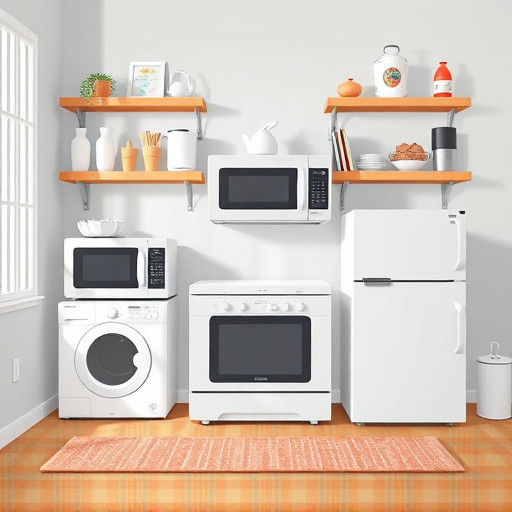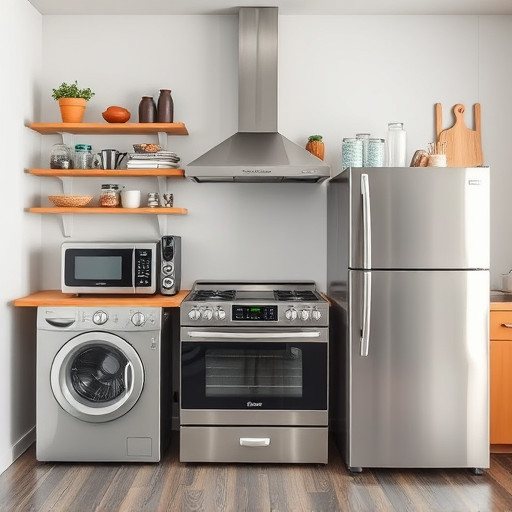Water leaks in dishwashers, caused by worn door seals, loose connections, and faulty gaskets, can lead to mold growth and structural damage. Regular maintenance, including inspecting and replacing door seals, is crucial for homeowners to prevent these issues in major appliances. By maintaining airtight seals, homeowners reduce energy waste, safeguard kitchens from water damage, and ensure optimal appliance performance. Early detection of leaks and proper seal replacement or repair can save costs and prolong the lifespan of major appliances like dishwashers.
Water leaks in dishwashers can cause significant damage, from water stains on cabinets to mold growth. Understanding common causes and their impact is crucial for major appliance maintenance. Door seals play a vital role, acting as the unseen guardian of your kitchen by preventing water leaks. This guide delves into identifying worn-out seals, offers a step-by-step replacement process, and provides maintenance tips to prolong your dishwasher’s door seal life.
- Understanding Water Leaks in Dishwashers: Common Causes and Impact
- Role of Door Seals: The Unseen Guardian of Your Kitchen
- Identifying Worn-Out Door Seals: Signs and Symptoms
- Step-by-Step Guide to Replacing Dishwasher Door Seals
- Maintenance Tips: Prolonging the Life of Your Dishwasher Door Seal
Understanding Water Leaks in Dishwashers: Common Causes and Impact

Water leaks in dishwashers are more common than you might think, often going unnoticed until they cause significant damage. Understanding the causes behind these leaks is essential for any homeowner with a major appliance. The most typical culprits include worn-out or damaged seals around the door, loose connections, and faulty gaskets. These issues can lead to water not only leaking out but also causing mold and mildew growth, damaging countertops, cabinets, and even flooring.
In major appliances like dishwashers, regular maintenance is key to preventing such problems. Regularly inspecting the door seals for any tears or cracks, ensuring proper alignment, and tightening connections can help extend the life of your appliance and avoid costly repairs.
Role of Door Seals: The Unseen Guardian of Your Kitchen

Door seals, often overlooked, play a pivotal role in keeping your kitchen dry and your major appliances running efficiently. These seemingly simple gaskets form an airtight barrier between the dishwasher and the surrounding cabinets, preventing water leaks that could cause costly damage to your floors and walls. By creating a tight seal, they ensure that cleaning power remains inside the machine where it belongs, reducing energy waste and enhancing the overall performance of your dishwasher.
Imagine coming home to a puddle on the floor, not knowing how or when it got there. This is a common issue for kitchens with faulty door seals. Water leaks can occur silently over time, going unnoticed until significant damage is done. Regularly checked and replaced door seals, however, serve as the unseen guardian of your kitchen, safeguarding against such surprises and ensuring that every load of dishes is cleaned efficiently without compromising your space’s integrity.
Identifying Worn-Out Door Seals: Signs and Symptoms

Many homeowners often overlook the importance of their dishwasher’s door seal until it’s too late. Worn-out or damaged door seals in major appliances like dishwashers are common issues that can lead to significant water leaks. Identifying a problem early on is crucial to prevent costly damage and unnecessary stress.
Keep an eye out for signs such as persistent moisture or water stains around the door, which could indicate a breach in the seal. You may also notice small puddles forming at the base of your dishwasher after each cycle. If the door doesn’t close properly or feels loose, it’s likely the seal needs replacing. These symptoms are not only indicative of a leak but can also lead to decreased energy efficiency, as water will escape, requiring the machine to work harder to maintain the desired temperature.
Step-by-Step Guide to Replacing Dishwasher Door Seals

Replacing a dishwasher door seal is a straightforward task that can save you from costly water damage and ensure your major appliances run smoothly. Here’s a step-by-step guide to help you through the process:
1. Turn Off the Water Supply: Before you begin, make sure to turn off the water supply to your dishwasher. Locate the shut-off valves under the sink or in the utility room and twist them clockwise to stop the flow of water. This safety measure prevents any accidents during the replacement.
2. Remove the Old Seal: Next, open the dishwasher door and locate the old door seal. Use a putty knife to carefully pry away the seal from the door frame, taking note of its direction and how it’s attached. Once removed, clean the area to ensure no debris or residue remains.
3. Install the New Seal: Obtain a replacement door seal that fits your dishwasher model. Align the new seal with the door frame, ensuring it’s in the correct position. Secure it using adhesive or mechanical fasteners provided with the kit. Follow the manufacturer’s instructions for the best results.
4. Test and Adjust: Close the dishwasher door gently and check for any gaps or misalignments. Make adjustments as needed until the seal is secure and flat against the door frame. Turn on the water supply and check for leaks. If there are none, your replacement has been successful!
Maintenance Tips: Prolonging the Life of Your Dishwasher Door Seal

Regular maintenance is key to keeping your dishwasher running efficiently and preventing costly repairs. One often-overlooked aspect of care is the dishwasher door seal, a vital component in sealing in heat and steam while keeping water from escaping. To prolong the life of this essential part, keep these tips in mind.
First, regularly inspect the door seal for any tears, cracks, or worn spots. Even minor damage can compromise its ability to create a tight seal. Second, use a soft cloth slightly dampened with warm water to wipe down the seal after each wash cycle. This removes food debris and grime that could accumulate and affect its flexibility. Lastly, consider using a silicone-based lubricant sparingly on the seal to keep it pliable, ensuring it continues to form a secure fit. Remember, proper care of your dishwasher’s door seal is crucial not just for water conservation but also for maintaining the performance of your major appliance.
By addressing worn or damaged door seals, homeowners can prevent costly water damage and keep their major appliances running efficiently. Regular maintenance, as outlined in this guide, ensures your dishwasher’s door seal remains effective, protecting against water leaks and prolonging the life of your kitchen appliance. Investing in simple replacement parts can save you time, money, and potential headaches in the long run.
